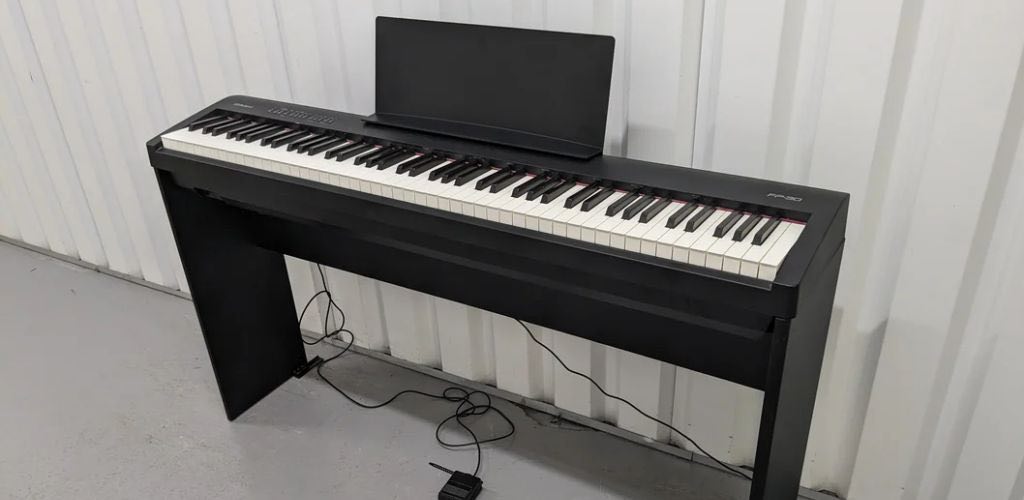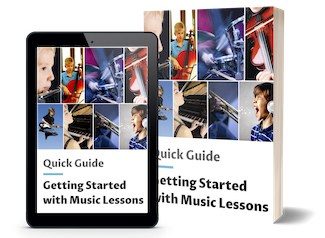I’ve spent countless hours testing digital pianos, and the Roland FP-30 consistently surprises me with how much quality it packs into such an affordable package. This 88-key digital piano has become my go-to recommendation for beginners and experienced players who need something portable without sacrificing sound quality.
The Roland FP-30 offers Roland’s acclaimed SuperNATURAL Piano sound engine and authentic weighted keys in a compact design that weighs just 31 pounds. What really caught my attention was how this piano manages to deliver premium features like Bluetooth connectivity and professional-grade speakers at a fraction of the cost of larger models.
I’m excited to walk you through everything that makes this digital piano special, from its impressive sound options and modern connectivity features to its clever design choices that make it perfect for tight spaces. Whether you’re curious about its recording capabilities, wondering how it connects to your favorite music apps, or trying to decide if it’s worth the investment, I’ll cover all the details that matter most.
Key Features of the Roland FP-30 Digital Piano
The Roland FP-30 combines three essential elements that make it stand out among digital pianos: advanced sound technology that mimics acoustic piano response, a weighted keyboard action with escapement feel, and flexible audio options for both private practice and performance.
Roland FP-30X Digital Piano

FEATURES: Standard keyboard with 88 keys and an ivory feel
OTHER INFO: With SuperNATURAL piano sound engine with 256-note polyphony
- Provides Bluetooth connectivity for wireless audio streaming and MIDI connection
- Offers a realistic touch and tone that closely resembles an acoustic piano
- Compact and lightweight design, making it easy to transport and set up in different locations
- None!
When you click ‘Check Price’, you’ll see there are loads of great places to buy this item. Our personal favorite is Sweetwater for the US, and Thomann and Gear4Music for the UK & Europe.
They are the largest music retailers, with excellent customer service, competitive prices, really fast shipping, and the longest guarantees.
The professional musician who wrote this article combined many things,
from the product build, manufacturer’s reputation through to feedback
from other users, to create our famous TedScore™.
SuperNATURAL Piano Sound Engine
I’ve found that the SuperNATURAL Piano sound engine sets the Roland FP-30 apart from other digital pianos in its price range. This technology creates rich, responsive tones that react to your playing style.

The sound engine uses 128-voice polyphony, which means I can play complex pieces without notes cutting off. This is crucial when using the sustain pedal or playing dense chord progressions.
Roland has built in several resonance features that enhance the piano experience:
- String Resonance – simulates how piano strings vibrate sympathetically
- Damper Resonance – recreates the effect of lifting the sustain pedal
- Key Off Resonance – adds subtle sound when keys are released
The FP-30 includes 6 piano tones plus additional sounds like electric pianos and organs. I appreciate that the stretched tuning is always active on piano sounds, matching how acoustic pianos are tuned.
PHA-4 Standard Keyboard Action
The keyboard action on this digital piano feels remarkably close to an acoustic instrument. Roland’s PHA-4 Standard keyboard gives me 88 fully weighted keys with escapement and Ivory Feel.
Each key is individually weighted to match the feel of a real piano. The bass keys feel heavier than the treble keys, just like on an acoustic piano.

I love the escapement mechanism that creates a subtle “click” when I press each key gently. This helps me develop proper finger technique and control.
The Ivory Feel coating on the keys provides:
- Better grip during long practice sessions
- Reduced slipping when my fingers get sweaty
- A more premium feel compared to plastic keys
The keyboard offers 5 touch sensitivity levels plus a fixed setting. This lets me adjust how the piano responds to my playing dynamics.
Speaker System and Headphone Options
The FP-30’s audio system delivers impressive sound for its compact size. I’m consistently surprised by the 11W x 2 amplifier and dual 12cm speakers that produce clear, full sound.
The speakers can reach 102 dB volume levels, which is plenty for home practice and small performances. The sound quality remains clean even at higher volumes.
For private practice, I use the dual headphone jacks that automatically mute the speakers. One jack takes standard 1/8″ headphones while the other accepts 1/4″ professional headphones.
The quiet keyboard action means I can practice with headphones any time without disturbing others. This makes the digital piano perfect for apartment living or late-night practice sessions.
I also appreciate that the headphone outputs can function as line outputs for connecting to recording equipment or external speakers when I need more volume for performances.
Sound and Performance Options
The Roland FP-30 delivers impressive sound variety and flexible performance modes that go far beyond basic piano playing. You’ll find multiple instrument voices, solid polyphony capabilities, and creative playing modes that enhance both practice and performance.
Built-In Instrument Voices
The FP-30 comes loaded with 35 different instrument sounds that I find genuinely useful. You get 6 piano tones powered by Roland’s SuperNATURAL Piano engine, which sounds remarkably authentic.
Beyond pianos, there are 7 electric piano voices that capture classic vintage sounds. I particularly enjoy the Rhodes and Wurlitzer emulations for jazz and rock playing.
The remaining 22 voices include:
- Organs – Perfect for gospel and rock styles
- Strings – Great for layering with piano
- Voices – Choir sounds that add atmosphere
- Synthesizer sounds – Modern electronic textures
Each voice responds naturally to my playing dynamics. The piano tones include string resonance and damper resonance that activate automatically.
Polyphony and Sound Quality
The FP-30 provides 128-voice polyphony, which means I can play complex pieces without notes cutting off unexpectedly. This is plenty for most playing situations, even when layering multiple sounds.
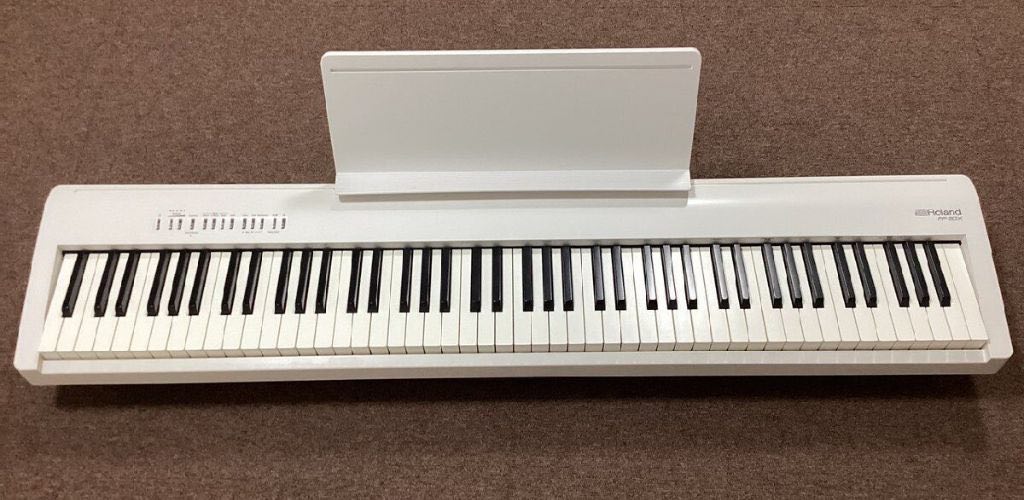
Roland’s SuperNATURAL Piano technology creates each note individually rather than using basic samples. This gives me much more expressive control over tone and dynamics.
The built-in speakers deliver 11 watts per channel through dual 12cm drivers. I’m impressed by how full and rich the sound is for a portable digital piano.
When I use headphones, the piano maintains its depth and clarity. The dual headphone outputs let me practice with a teacher or friend easily.
Dual, Split, and Twin Piano Modes
Dual mode lets me layer two sounds together, like combining piano with strings. I can adjust the volume balance between the two sounds to get exactly the blend I want.
Split mode divides the keyboard so I can play bass with my left hand and piano with my right. The split point is adjustable, giving me flexibility in how I arrange the sounds.
Twin Piano mode is brilliant for lessons – it splits the keyboard into two identical sections with the same octave range. My teacher and I can play the same exercises side by side without fighting over keys.
I also get access to 8 rhythm patterns that provide simple backing beats. These aren’t full arrangements, but they’re helpful for keeping time during practice sessions.
Connectivity and Modern Technology
The Roland FP-30 brings cutting-edge wireless and digital features that transform how you interact with your digital piano. I’ll explore the Bluetooth capabilities and USB connectivity options that make this instrument stand out.
Bluetooth Wireless Features
The built-in Bluetooth wireless connectivity opens up incredible possibilities with your smartphone or tablet. I can connect directly to popular music apps without any cables getting in my way.
Music apps like GarageBand, piaScore, and Sheet Music Direct work seamlessly with the FP-30. The wireless connection supports both MIDI data and music sheet page turning functions.
I find the hands-free page turning feature particularly useful during practice sessions. When I’m using apps like piaScore or Sheet Music Direct, I can turn digital sheet music pages using the optional KPD-70 pedal unit.
The Bluetooth feature operates on version 4.0 technology for reliable connections. However, I should note that Bluetooth availability may vary depending on the country where the piano was purchased.
Bluetooth Wireless Features
The FP-30 includes both USB Computer and USB Memory ports for versatile connectivity options. I can save my recorded performances as Standard MIDI Files directly to USB flash memory.
The piano supports WAV audio file playback at 44.1 kHz, 16-bit quality through the USB Memory port. I can play along with my favorite songs stored on a USB drive.
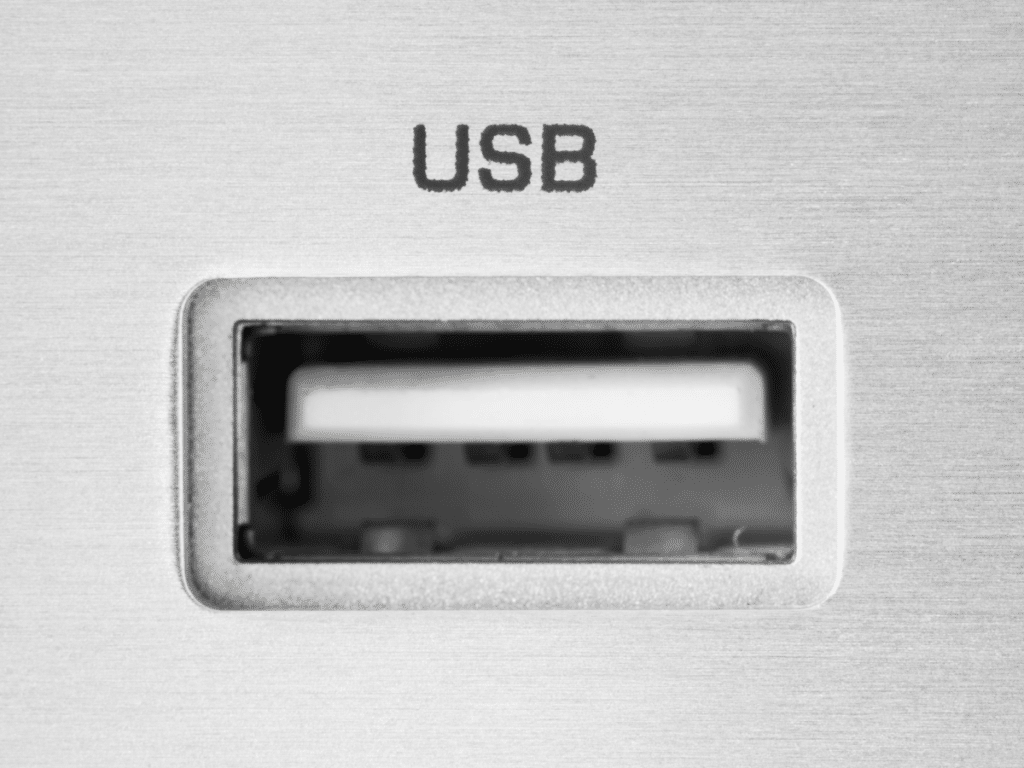
Recording capabilities include approximately 30,000 notes of storage in Standard MIDI File format. The built-in SMF recorder lets me capture my performances with full tempo and mix balance controls.
For computer connectivity, the USB Computer port enables direct interface with music production software. I can record tracks and use the FP-30 as a MIDI controller for digital audio workstations.
Integration With Music Apps
The Roland FP-30 opens up exciting possibilities when paired with popular music apps. I’ve found that two standout integrations make practicing and performing much more enjoyable.
piaScore Compatibility
I love how the FP-30 works seamlessly with piaScore through its USB connection. This digital sheet music app transforms my tablet into a smart music stand that responds to my playing.
When I connect my piano via USB cable, piaScore can detect when I’ve finished a page. The app automatically turns pages for me, which keeps my hands free to focus on playing.
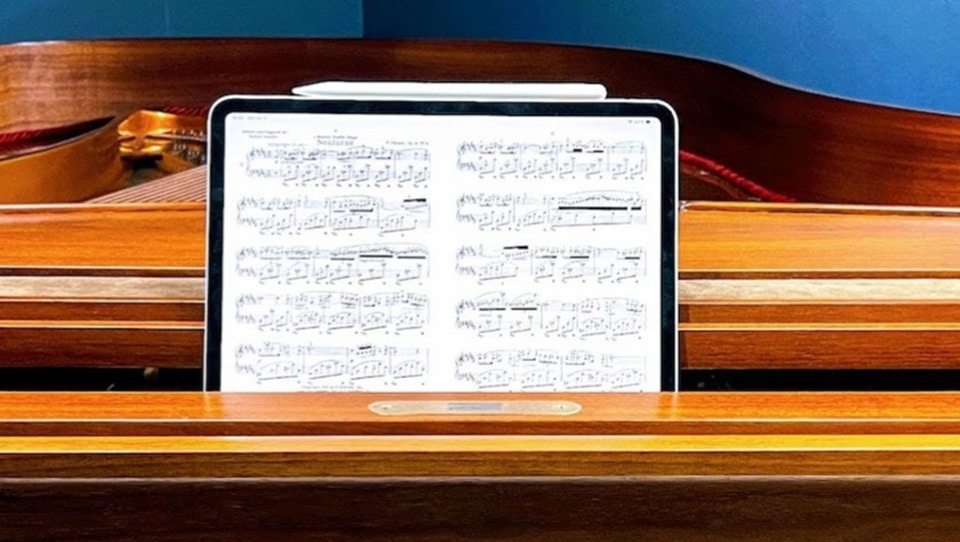
This feature works especially well during practice sessions when I don’t want to break my flow.
The app also lets me annotate my digital scores directly. I can add fingering numbers, practice notes, or highlight tricky passages. These markings sync across all my devices, so my practice notes are always available whether I’m using my tablet or phone.
PiaScore’s metronome feature integrates nicely with the FP-30’s audio output. I can hear both the piano sounds and the metronome click through my headphones, creating a distraction-free practice environment.
Sheet Music Direct Integration
Sheet Music Direct brings thousands of songs right to my fingertips when paired with the FP-30. I can purchase and download sheet music instantly, then play it directly from my tablet while my piano provides the audio.
The app’s transpose feature works beautifully with the FP-30’s own transpose function. If I need to change keys, I can adjust either on the piano or in the app. This flexibility helps me play songs in comfortable ranges or match other instruments.
I particularly enjoy the app’s playback feature during learning sessions. Sheet Music Direct can play the melody while I practice the accompaniment on my FP-30. This gives me a full band experience even when practicing alone.
The app also offers different arrangement levels for popular songs. I can start with simplified versions and gradually work up to more complex arrangements as my skills improve.
Recording and Practice Tools
The FP-30 includes essential practice features that help you develop your playing skills. The built-in MIDI recorder and metronome functions provide everything you need for effective practice sessions.
Korg MA-2 Metronome

COMES WITH: A Larger and more easily readable display
FEATURES: Timer, enhanced volume, and a useful 'sound-out' mode
Korg MA-2 Metronome
- Has a Tap Tempo function, making it super easy to use
- Earphone jack with adjustable volume
- Stylish display
- Compact - so easy to travel
- None!
When you click ‘Check Price’, you’ll see there are loads of great places to buy this item. Our personal favorite is Sweetwater for the US, and Thomann and Gear4Music for the UK & Europe.
They are the largest music retailers, with excellent customer service, competitive prices, really fast shipping, and the longest guarantees.
The professional musician who wrote this article combined many things,
from the product build, manufacturer’s reputation through to feedback
from other users, to create our famous TedScore™.
Onboard MIDI Recorder
I love how the FP-30’s built-in recorder captures my playing as MIDI data. This means I can save my performances and listen back to them later for self-evaluation.
The MIDI recorder stores up to 30,000 notes in Standard MIDI File format. I can save one song in the piano’s internal memory at a time.
For longer recording sessions, I use USB memory to store multiple recordings. The recorder saves files as Format 0 MIDI files that work with most music software.
The recording controls are simple to use:
- Song Select – Choose which recording to play
- Play/Stop – Control playback
- Rec – Start recording
- Count-in – Get a beat before recording starts
I find the mix balance feature particularly helpful. It lets me adjust the volume between my recorded performance and any backing tracks I’m playing along with.
Metronome and Rhythm Functions
The built-in metronome keeps me on tempo during practice. I can set it anywhere from 20 to 250 beats per minute to match any song speed.
The metronome offers six different time signatures: 0/4, 2/4, 3/4, 4/4, 5/4, and 6/4. This covers everything from waltzes to complex classical pieces.
What makes practice even more fun are the 8 rhythm patterns. These drum backing tracks help me play in different musical styles and keep steady time.
The rhythm functions include:
- Start/Stop controls
- Tempo adjustment from 20-250 BPM
- Rhythm selection between 8 different patterns
I use these rhythms when practicing pop songs or jazz pieces. They make solo practice feel more like playing with a band.
Design, Portability, and Accessories
The Roland FP-30 strikes an impressive balance between premium build quality and practical portability. This digital piano weighs about five pounds more than its competitors, giving it a reassuring substantiality with super-clean design.
Compact and Lightweight Body
I find the FP-30’s dimensions perfectly suited for modern living spaces. The piano measures just over 50 inches wide and weighs approximately 37 pounds, making it manageable for one person to move.
The compact size fits any space with ease while maintaining the full 88-key layout. I appreciate how Roland didn’t compromise on key size or spacing despite the streamlined form factor.

The build quality feels solid in my hands. The extra weight compared to competitors actually works in the piano’s favor, reducing vibrations during intense playing sessions.
Moving the FP-30 between rooms or venues is straightforward. The balanced weight distribution makes carrying comfortable, even without a case.
Color and Finish Choices
The FP-30 comes in classic black and white finishes. Both options feature a matte texture that resists fingerprints and scratches.
I prefer the black model for its professional stage appearance. The white version looks elegant in home settings and complements modern décor.
The control panel uses subtle silver accents on both colors. The minimalist button layout maintains the clean aesthetic while keeping essential functions accessible.
Roland’s finish quality matches higher-end models in their lineup. The surface feels premium and shows little wear even after regular use.
I’ve gathered answers to the most common questions about the Roland FP-30, covering comparisons with other models, accessories, buying tips, and user feedback. You’ll also find information about where to locate the user manual.
FAQ's
The FP-30 offers significant upgrades over the FP-10 in several key areas. I notice the FP-30 features Roland’s PHA-4 Standard keyboard with escapement and ivory feel, while the FP-10 uses a simpler key action.
The FP-30 includes more built-in sounds and better speakers for improved audio quality. It also has more connectivity options, including USB and Bluetooth capabilities that the FP-10 lacks.
Both models share the same 88-key layout, but the FP-30 provides a more authentic piano playing experience. The price difference reflects these enhanced features and build quality.
The FP-30X is the newer version that replaced the original FP-30 model. I find the FP-30X includes updated sound samples and improved Bluetooth connectivity features.
The FP-30X offers more built-in songs and enhanced practice functions compared to the original FP-30. It also features updated mobile app compatibility for modern devices.
Both models share the same keyboard action and basic sound engine. The differences are mainly in the additional features and connectivity options available on the newer FP-30X.
I recommend getting a sturdy X-style keyboard stand or a furniture-style stand depending on your needs. The Roland KS-12 stand pairs well with the FP-30 for a stable setup.
For pedals, the Roland DP-10 damper pedal works perfectly with the FP-30. You can also use the triple pedal unit RP-501R if you want a full three-pedal experience.
A good bench is essential for proper playing posture. I suggest looking for an adjustable bench that matches your playing height and comfort preferences.
I always check that all 88 keys work properly and feel consistent when pressed. Test each key for proper sound response and make sure none stick or feel loose.
Look for any physical damage like cracks, scratches, or missing parts. Check that all connections work, including USB, headphone jacks, and power input.
Make sure the original power adapter is included, as replacement adapters can be expensive. Ask about the purchase date and any warranty information that might transfer.
Users consistently praise the FP-30’s realistic key feel and authentic piano sounds. I see many reviews highlighting the quality of the PHA-4 keyboard action for the price range.
The compact design and portability receive frequent positive mentions from users. Many appreciate that it delivers acoustic piano feel without taking up much space.
Some users note that the built-in speakers could be louder for larger rooms. Others mention wanting more advanced features like recording capabilities.
You can view the Roland FP-30 manual for free online through several manual websites. I find these digital versions easy to search and bookmark for quick reference.
The Roland FP-30 owner’s manual PDF download is available on ManualsLib for offline viewing. This 18-page manual covers setup, features, and troubleshooting.
Roland’s official website also provides access to product manuals and support documents. You can contact Roland customer service if you need a replacement physical manual.


